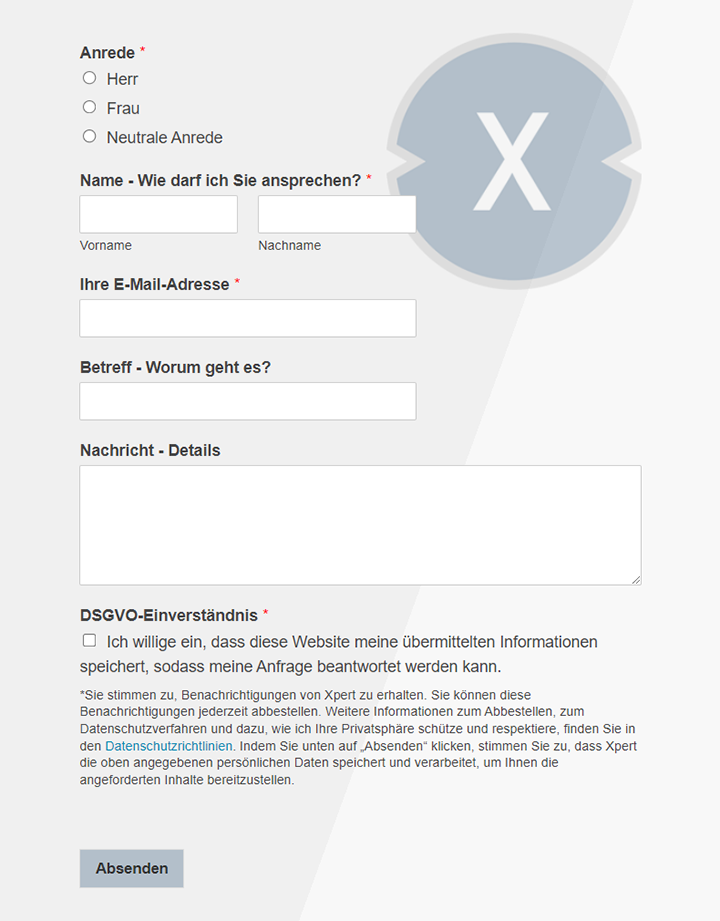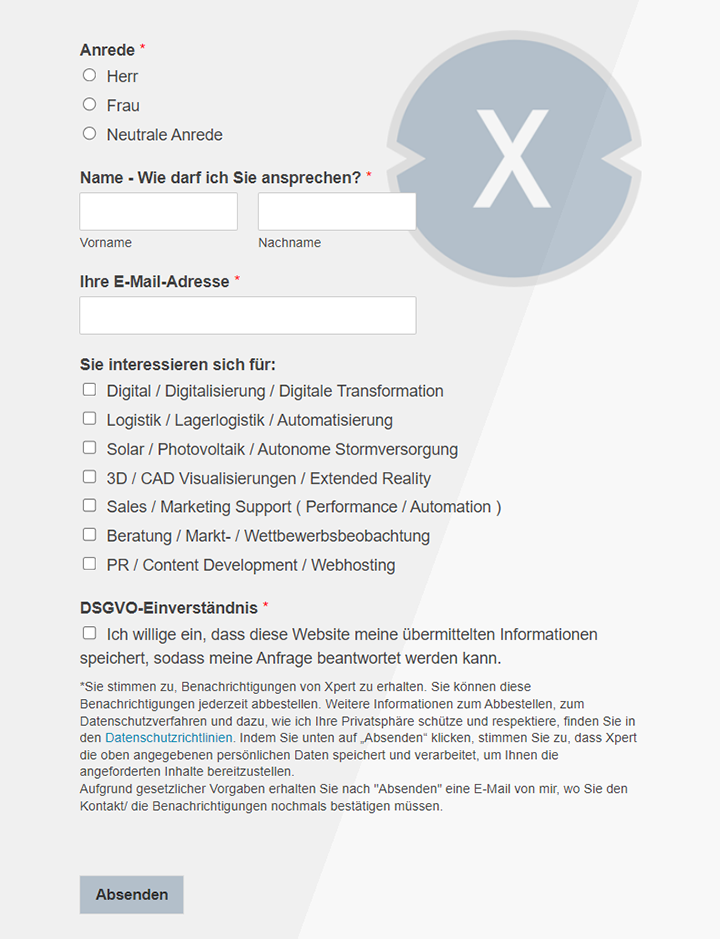Climate Neutrality: A Comprehensive Guide for Businesses – White Paper Notes & Analysis
Language selection 📢
Published on: June 4, 2024 / update from: June 4, 2024 - Author: Konrad Wolfenstein

Climate neutrality: A comprehensive guide for companies - WhitePaper notes & analysis - Image: Xpert.digital
🌎🔧 strategies and tools to achieve climate neutrality in companies
📊🌱 climate neutrality as a challenge: a systematic approach for companies
In times of growing environmental awareness and increasingly stricter legal requirements, the topic of climate neutrality becomes more important for companies every day. But how can a company successfully take this path?
Achieving climate neutrality is undoubtedly a challenge, but this can be mastered with determination and systematic approach. Companies are available to numerous tools and strategies to minimize their emissions and have a positive impact on the climate. By combining these measures, companies can not only reduce their ecological footprint, but also make their contribution to a sustainable future.
Here are not just twenty tips, but a detailed timetable of how companies can improve their climate balance and become climate -neutral in the long term.
🌱 1. Creation of a climate balance
The first step on the way to climate neutrality is to create a comprehensive climate balance. This balance sheet records all greenhouse gas emissions caused by the business activities of a company. This includes direct emissions from own sources and indirect emissions from the consumption of electricity, heat or steam as well as from the entire supply chain. Only through a clear understanding of the current emission profile can a company develop suitable measures to reduce these emissions.
🎯 2. Set goals for emission reduction
After the starting point is clear, concrete and measurable goals should be determined to reduce emissions. These goals should not only aim at short -term improvements, but also target long -term reductions. The ideal are goals that are in accordance with the Paris climate agreement, i.e. a significant reduction in greenhouse gases by 2050.
⚡️ 3. Increase energy efficiency
An essential lever to reduce emissions is the increase in energy efficiency. This can be achieved by investing in modern, energy -efficient technologies, optimizing production processes and using energy -efficient buildings. Even small measures such as the use of energy -efficient lighting or improving insulation can have large effects.
🌞 4. Use renewable energies
The switch to renewable energies is one of the most effective ways to reduce a company's CO2 balance. Companies should try to convert as much as possible to renewable energy sources such as solar, wind or hydropower. The purchase of green electricity can also be a sensible measure.
📦 5. Sustainable supply chains
Another decisive factor is the sustainability of the entire supply chain. Companies should make sure that their suppliers and partners also apply climate -friendly practices. This requires close cooperation and possibly also the switch to alternative, more sustainable suppliers.
🌳 6. Compensation inevitable emissions
Even with the best efforts, emissions often remain that cannot be completely avoided. These can be compensated for by compensation. Projects such as reforestation initiatives or investments in renewable energies in developing countries are examples of how companies can compensate for their remaining emissions.
👩🏫 7. Integrate and train employees
Sustainable change only succeeds if all employees pull together. Companies should train their employees regularly and actively integrate them into the process. Sensitization measures and clear communication of the corporate goals are just as important as promoting ideas to improve sustainability from all areas of the company.
🌟 8. Promote innovations
Sustainability and climate neutrality are often the result of innovations. Companies should create a culture that promotes innovations and new technologies. This can be done through investments in research and development or through partnerships with start-ups and scientific institutions.
📈 9. Transparency and reporting
Transparency is a key aspect on the way to climate neutrality. Companies should report regularly and openly about their progress. Transparent reporting not only promotes customers and partners, but also facilitates the internal tracking of the goals set.
🎯 10. Long -term strategic planning
Sustainability should be firmly anchored in the long -term corporate strategy. This means that climate neutrality should flow into all business decisions, be it in the development of new products, the selection of suppliers or investment decisions. A sustainable strategy also requires regular reviews and adjustments to the procedure in order to meet the changing framework conditions and technological advances.
🤝 11. Partnerships and cooperation
Companies should consider the opportunity to work with other companies and organizations to work together on climate goals. Cooperation can create synergies and make it possible to achieve greater effects than through individual efforts alone. Industry initiatives or memberships in environmental organizations can make a valuable contribution to this.
📣 12. Strengthen consciousness of the customers
In addition to internal efforts, it is also important to inform customers about their own sustainability initiatives. Transparent communication via product packaging, the company website and in marketing campaigns can help strengthen the awareness of customers and to create greater demand for more sustainable products and services.
💻 13. Use digitization
Digitization offers numerous ways to make business processes more efficient and therefore more environmentally friendly. From paperless offices to intelligent energy management systems to data -driven decisions - technologization offers numerous tools to reduce ecological footprint.
🏷 14. Sustainability certificates and labels
Acquiring sustainability certificates can help companies officially recognize their efforts and to document their commitment to the outside world. Labels such as "CO2-neutral", "Öko-Tex" or the "European environmental sign" can strengthen consumers' trust in the company's sustainability efforts.
✔️ 15. Regular audits and reviews
Regular audits and reviews of one's own sustainability measures are essential to monitor progress and ensure that the strategies are effective. Ideally, these checks should be carried out by independent third parties to ensure objectivity and credibility.
🌿 16. Encourage customers to participate
Innovative campaigns that encourage customers to participate in the company's sustainability efforts can bring a significant additional benefit. This includes withdrawal systems for products, incentives for environmentally friendly behavior or educational campaigns that encourage consumption to consume more sustainably.
🔄 17. Recyclebare and sustainable materials
The use of recyclable and sustainable materials in production processes is another important aspect. This not only reduces the amount of waste, but also reduces resource consumption and thus CO2 emissions.
🚛 18. Green logistics
Logistics and transport are often considerable emission sources. Companies can significantly reduce environmental pollution by optimizing logistical processes, the use of low -emission vehicles and improving route planning. Cooperation with logistics service providers who apply sustainable practices also contributes to reducing the CO2 balance.
📦 19. Environmental packaging
The choice of environmentally friendly packaging is another key area. Companies should do without disposable plastic and instead rely on reusable or biodegradable materials. This not only helps to avoid waste, but also has a positive impact on the brand image.
🔄 20. Long -term switch to circular economy
Ultimately, the goal of every company should be to establish a circular economy. This means that products are designed in such a way that they can be recycled or completely attributed to the production process at the end of their lifespan. This significantly reduces resource consumption and the amount of waste and leads to a long -term sustainable business model.
📣 Similar topics
- 📣 Climate neutrality: Paths for companies to the green future
- 🌍 design and optimize sustainable supply chains
- 🔥 Increase energy efficiency: measures and advantages
- 💡 Use renewable energies for companies
- 📊 Transparency and reporting in sustainability
- 🔨 promotion of innovation for a climate -friendly future
- 🤝 partnerships and cooperation for climate goals
- 🛠 Environmentally friendly packaging and green logistics
- 📢 Customer participation in sustainability initiatives
- 🏢 long -term switch to circular economy
#️⃣ hashtags: #climate neutrality #sustainability #Energie efficiency #erneuerenenergies #green elogistics
📌 Other suitable topics
🎯🎯🎯 Benefit from Xpert.Digital's extensive, fivefold expertise in a comprehensive service package | R&D, XR, PR & SEM

AI & XR 3D Rendering Machine: Fivefold expertise from Xpert.Digital in a comprehensive service package, R&D XR, PR & SEM - Image: Xpert.Digital
Xpert.Digital has in-depth knowledge of various industries. This allows us to develop tailor-made strategies that are tailored precisely to the requirements and challenges of your specific market segment. By continually analyzing market trends and following industry developments, we can act with foresight and offer innovative solutions. Through the combination of experience and knowledge, we generate added value and give our customers a decisive competitive advantage.
More about it here:
🌍 economically sensible ways to climate neutrality
💡 The way to climate neutrality is one of the most important challenges of our time. It requires profound rethinking and acting in almost all economic sectors. But this challenge also brings immense opportunities. On an economically sensible path to climate neutrality, not only ecological goals can be achieved, but also economic advantages can be achieved. This text illuminates various approaches and measures that make both ecologically and economically useful.
🌞💨 1. Renewable energies as the cornerstone
One of the central pillars of climate neutrality is the increased use of renewable energies. Wind, solar and hydropower offer clean alternatives to fossil fuels. The costs of the production of renewable energies have dropped significantly in recent decades, which makes it an economically attractive option. The International Energy Agency (IEA) has reported that solar energy is now the cheapest power source in history.
The advantages of renewable energies go beyond the reduction of greenhouse gases. They create jobs in new industries, reduce dependencies on imported fossil fuels and ensure long -term energetic independence.
⚡🏠 2. Energy efficiency and energy saving
Another economically sensible measure is to improve energy efficiency. Buildings, industrial plants and transport systems consume a large part of the energy. The use of modern technologies and more efficient processes can be significantly reduced. Energetic renovations of buildings, the use of LED lighting and energy-efficient household appliances are just a few examples.
In addition to technical optimization, the change in behavior also plays a crucial role. The introduction of intelligent power grids (smart grids) and the conscious use of energy make it possible to control consumption and avoid lace loads.
🚗🔋 3. Electrification of the traffic sector
The traffic sector is one of the largest CO₂ emitters. The switch to electromobility therefore plays a key role in achieving climate neutrality. Electric vehicles (EVS) do not emit direct emissions during their operation and are more efficient than their petrol or diesel-powered counterparts.
State funding programs, the expansion of charging infrastructure and technological advances make electric vehicles more and more attractive. In addition, electric vehicles reduce dependence on fossil fuels and contribute to improving air quality.
🔄♻️ 4th circular economy and resource management
A future -oriented approach to reducing greenhouse gas emissions lies in the concept of the circular economy. This model strives to keep raw materials and products in the usage cycle as long as possible by promoting recycling, reprocessing and reuse.
By minimizing waste and maximizing resource productivity, industry can achieve significant savings. Companies benefit not only through cost reductions, but also through the creation of new business areas and innovations. This not only spares the environment, but also increases competitiveness.
🌾🌍 5. Promotion of sustainable agriculture
Agriculture is responsible for a significant part of greenhouse gas emissions. In order to operate climate -neutral, sustainable agricultural practices must be introduced and promoted. This includes reducing methane emissions through improved animal husbandry, the use of precision agriculture to optimize resource use and the promotion of agroforS systems that increase biodiversity and bind CO₂.
Reducing food waste also plays an important role. Food losses along the entire value chain not only cause economic losses, but also unnecessary greenhouse gas emissions. Through targeted measures to reduce these losses, a significant contribution to climate protection can be made.
🏭🔧 6. Innovative industrial sector
Industry is an essential part of a climate -neutral economy. Technological innovations and process optimizations can help to significantly reduce the emissions of industry. The use of hydrogen as an energy source is a promising option, especially in energy-intensive industries such as steel and chemical industry.
By using green hydrogen, which is obtained from renewable energies, fossil fuels can be replaced and the CO₂ emissions can be significantly reduced. However, these changes require considerable investments in infrastructure and research, but also offer great economic opportunities.
📜📈 7. Political framework and incentives
No way to climate neutrality can succeed without adequate political framework and incentives. Governments must support change towards a climate -neutral economy through laws, guidelines and funding programs. Emissions trading systems, CO₂ taxes and subsidies for green technologies are just a few of the measures that governments can take.
The creation of a stable and predictable legal framework gives companies security to invest in climate -friendly technologies and processes. At the same time, public investments in research and development can accelerate the innovations that are necessary to achieve the climate goals.
🌐🤝 8. International cooperation
Climate change knows no limits, and therefore the solution to this global problem requires close international cooperation. Countries have to work together to share technological developments, exchange best practice and to initiate projects together.
Multilateral agreements and international organizations play a key role in coordination and implementing global climate protection measures. By bundling resources and know-how, the international community can react more efficiently and quickly to the challenges of climate change.
👷♂️⚖️ 9. Effects on jobs and social justice
The transition to a climate -neutral economy will inevitably bring profound changes in the labor market and in society. While jobs disappear in some sectors, new employment opportunities are created in other areas. It is therefore essential to take labor market policy measures in order to make this change socially acceptable.
Retraining programs and further training initiatives are necessary to qualify employees for new, green jobs. At the same time, social security networks have to be strengthened in order to cushion the transition and reduce social inequalities.
📚💡 10. Consciousness and education initiatives
After all, education and consciousness formation play a crucial role on the way to climate neutrality. The promotion of environmental awareness and the imparting of knowledge about sustainable practices are already beginning in schools and universities. The integration of climate protection topics in the educational plans ensures that coming generations are better prepared for the challenges.
Companies and organizations also benefit from such education initiatives, since informed and motivated employees and citizens can contribute new ideas and can actively contribute to transformation.
🔭🔬 holistic and integrated approach
The way to climate neutrality requires a holistic and integrated approach. Economically sensible measures to reduce greenhouse gas emissions not only offer ecological advantages, but also significant economic opportunities. By relying on renewable energies, increasing energy efficiency, electrifying the traffic, promoting a circular economy, operating sustainable agriculture, promoting innovations in industry, creating political incentives, working internationally together, ensuring and promoting social justice, we can master the transition to a climate -neutral economy.
Change to climate neutrality is not an easy way, but it is necessary and feasible. It is in our hands to make the future more environmentally friendly and economically healthier.
📣 Similar topics
- 🌞 Energy of the future: Renewable energies as the key to climate neutrality
- ⚡ Efficient solutions: energy savings and technology trends
- 🚗 electric transport: change to climate -friendly mobility
- ♻️ circular economy: sustainability and resource efficiency
- 🌾 Agriculture of the future: sustainable practices and climate protection
- 🏭 innovative and green: The role of industry in climate protection
- 📜 Politics for the planet: framework conditions and incentives
- 🤝 Global cooperation: Together against climate change
- 👷♂️ New working worlds: jobs and social justice in change
- 📚 Environmental education: raise awareness and climate -friendly initiatives
#️⃣ hashtags: #erneuarbarenenergies #Energie efficiency #electromobility #kreislaufwirtschaft #sustainability
- Warehouses, production halls and industrial halls with their own power source from a photovoltaic roof system - Image: NavinTar|Shutterstock.com
- Industrial plant with its own power source from an outdoor photovoltaic system - Image: Peteri|Shutterstock.com
- Plan solar systems with photovoltaic solutions for freight forwarding and contract logistics
- B2B solar systems and photovoltaic solutions & advice
- Plan photovoltaics for warehouses, commercial halls and industrial halls
- Industrial plant: Plan a photovoltaic open-air system or open-space system
- Plan solar systems with photovoltaic solutions for freight forwarding and contract logistics
- B2B solar systems and photovoltaic solutions & advice
We are there for you - advice - planning - implementation - project management
☑️ SME support in strategy, consulting, planning and implementation
☑️ Creation or realignment of the digital strategy and digitalization
☑️ Expansion and optimization of international sales processes
☑️ Global & Digital B2B trading platforms
☑️ Pioneer Business Development
I would be happy to serve as your personal advisor.
You can contact me by filling out the contact form below or simply call me on +49 89 89 674 804 (Munich) .
I'm looking forward to our joint project.
Xpert.Digital - Konrad Wolfenstein
Xpert.Digital is a hub for industry with a focus on digitalization, mechanical engineering, logistics/intralogistics and photovoltaics.
With our 360° business development solution, we support well-known companies from new business to after sales.
Market intelligence, smarketing, marketing automation, content development, PR, mail campaigns, personalized social media and lead nurturing are part of our digital tools.
You can find out more at: www.xpert.digital - www.xpert.solar - www.xpert.plus




































